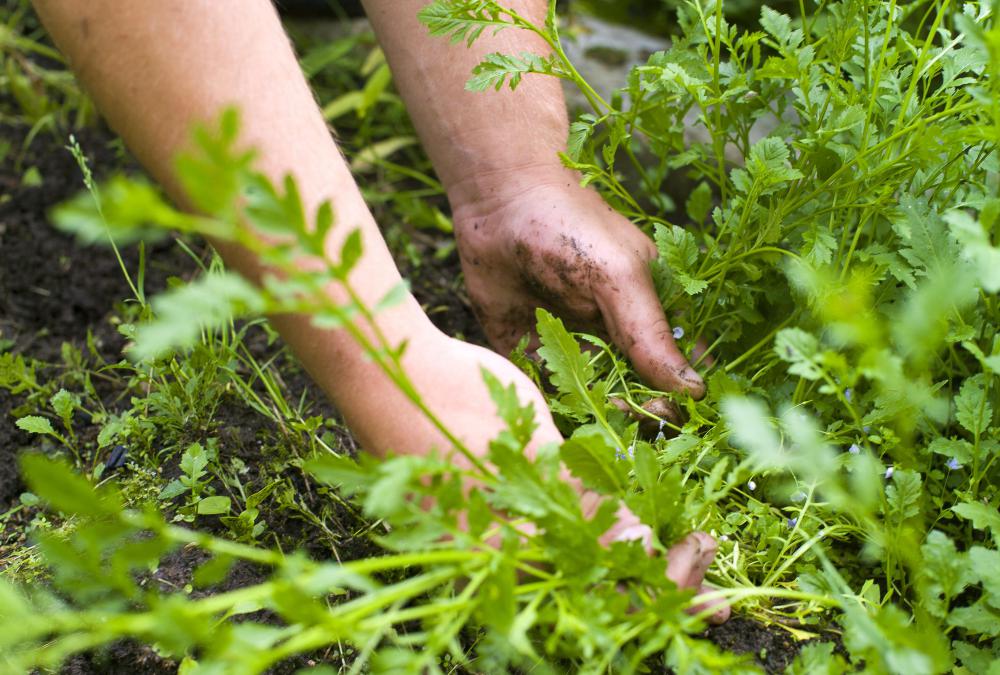At WiseGEEK, we're committed to delivering accurate, trustworthy information. Our expert-authored content is rigorously fact-checked and sourced from credible authorities. Discover how we uphold the highest standards in providing you with reliable knowledge.
How do Weed Killers Kill Weeds and Not Lawns?
Herbicides are complicated chemicals and the way they work depends largely on the type being used. There are two primary types of herbicides or weed killers – pre-emergence and post-emergence. Pre-emergence herbicides kill plant life while the seed is germinating, while post-emergence herbicides kill weeds during active growth. Both types of weed killer can be selective or nonselective, which is the reason certain weed killers target weeds but not lawns.
An easier explanation of how weed killers work without killing lawns is to understand what weeds are. Weeds are simply plant life growing in an undesirable place. In other words, what may be considered a weed in one location is considered a plant in another. Herbicides are applied to kill weeds when they are growing in an undesirable location. By using a selective herbicide that targets broadleaf plants, for example, weeds can be killed without harming most grasses.

The science behind how herbicides kill weeds is linked to cell growth and development. Because there are different types of weed killer, there are different ways to get rid of weeds, but essentially all herbicides destroy certain plant enzymes that are necessary for growth. There are also different types of plant life and since grassy plants develop differently than broadleaf plants, they respond differently to different weed killers. So while some herbicides kill weeds without harming grass, others will kill all plant life.

Nonselective herbicides are a category of weed killers that kill weeds, grass, and basically all plants. Roundup® is an example of a popular brand nonselective herbicide. When applied, nonselective herbicides kill all plant life, but they still remain useful for areas such as patios, walkways, and driveways where all plant growth is undesired. Caution should be used when applying nonselective herbicides because they can harm shrubs, trees and other nearby plants it may come in contact with.

To successfully kill undesirable broadleaf plants, such as crabgrass, clover, dandelions, and thistle, without killing the grassy plants that comprise a desirable lawn, choose a selective herbicide. These will attack the broadleaf plants and thus kill weeds without harming grass. Since methods of application vary depending on the type of weed killer used, be sure to thoroughly read the manufacturer’s directions for product use before applying any weed killer.
AS FEATURED ON:
AS FEATURED ON:














Discussion Comments
I gave up on expensive weed killers and am testing household vinegar, and so far am impressed with the results. The vinegar is acidic acid and it dries out the moisture of the flowering part of the weed, therefore starving the root. As long there is no rain the weed begins to die.
I applied Spectracide Weed Stop for St. Augustine and Centipede Lawns about a week ago to my St. Augustine grass. Now it's turning brown. Help!
Actually crabgrass is a weed. We're about to put down our crabgrass pre-emergent starting this week. On the other hand Quackgrass is a grass and not a weed. You can't selectively kill a grass, like Quackgrass, without killing the rest of your desirable grasses like Kentucky Blue Grass or Fine Fescue. However, you can kill crabgrass because it is a broad leaf weed.
Crabgrass is a grass like the name implies, not a broadleaf like article implies. Always check labels for listed weeds and if it doesn't work, try a different mode of action.
Can anyone tell me about a weed killer called
kumba-m ? It kills weeds in the lawn but is it safe?
Here's one for you folks. When you go out to your local home depot or lowes and get your weed and feed for your lawn. It says it will kill all these weeds and dandelions.
You apply it to your yard and all these weeds disappear so you think you have killed them right? Wrong! Those weeds and dandelions are alive and well in a state of hibernation. That's why when you don't put enough weed and feed on one year your whole yard is immediately covered in dandelions with roots as big as your thumb.
It doesn't say how; it only labels types of herbicides and says that some are formulated to kill a specific plant. It does not say how. If this were an article on the classification of herbicides, it would be great; however, it is titled how!
except if all weeds died a lot of animals would also die.
i think weeds should all die!!!
Post your comments